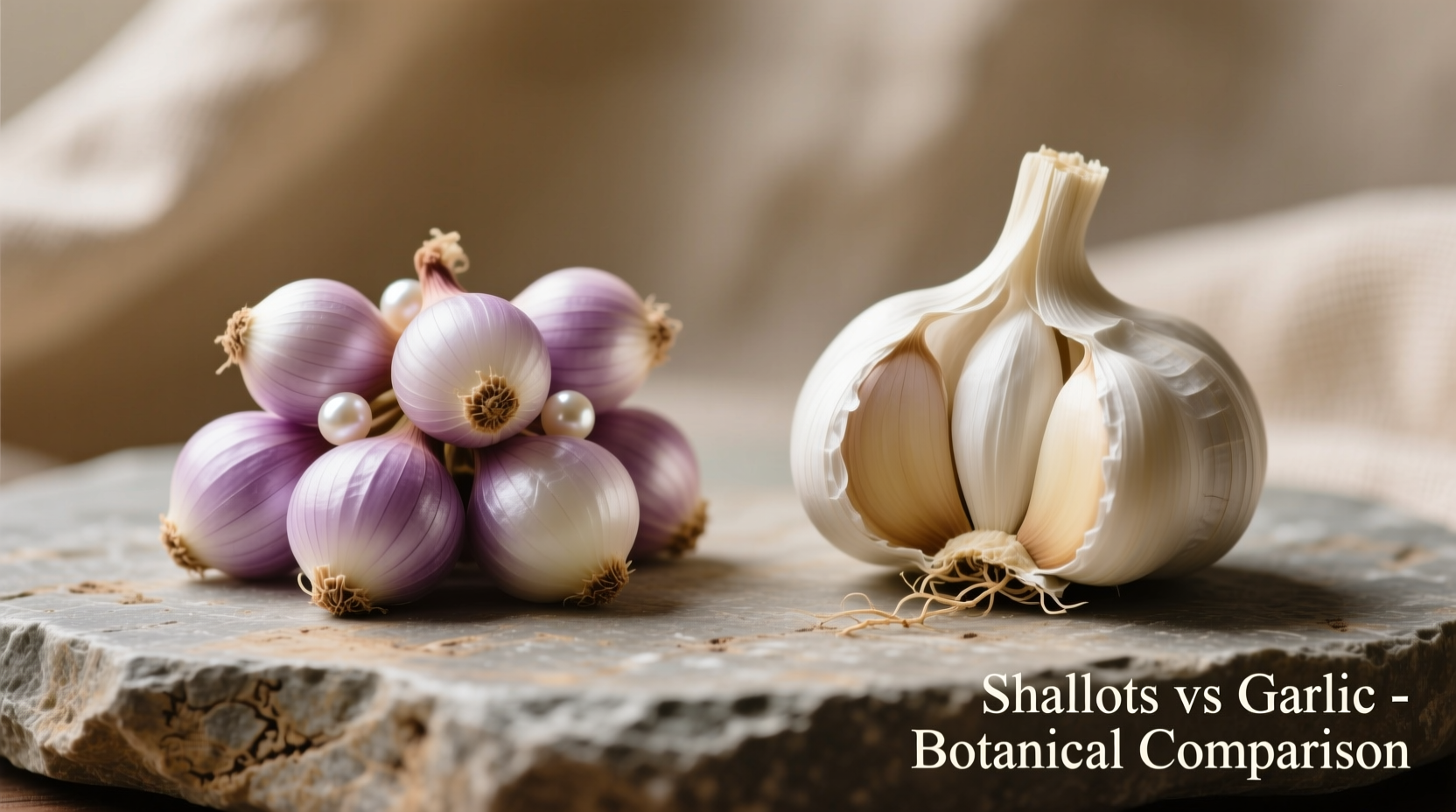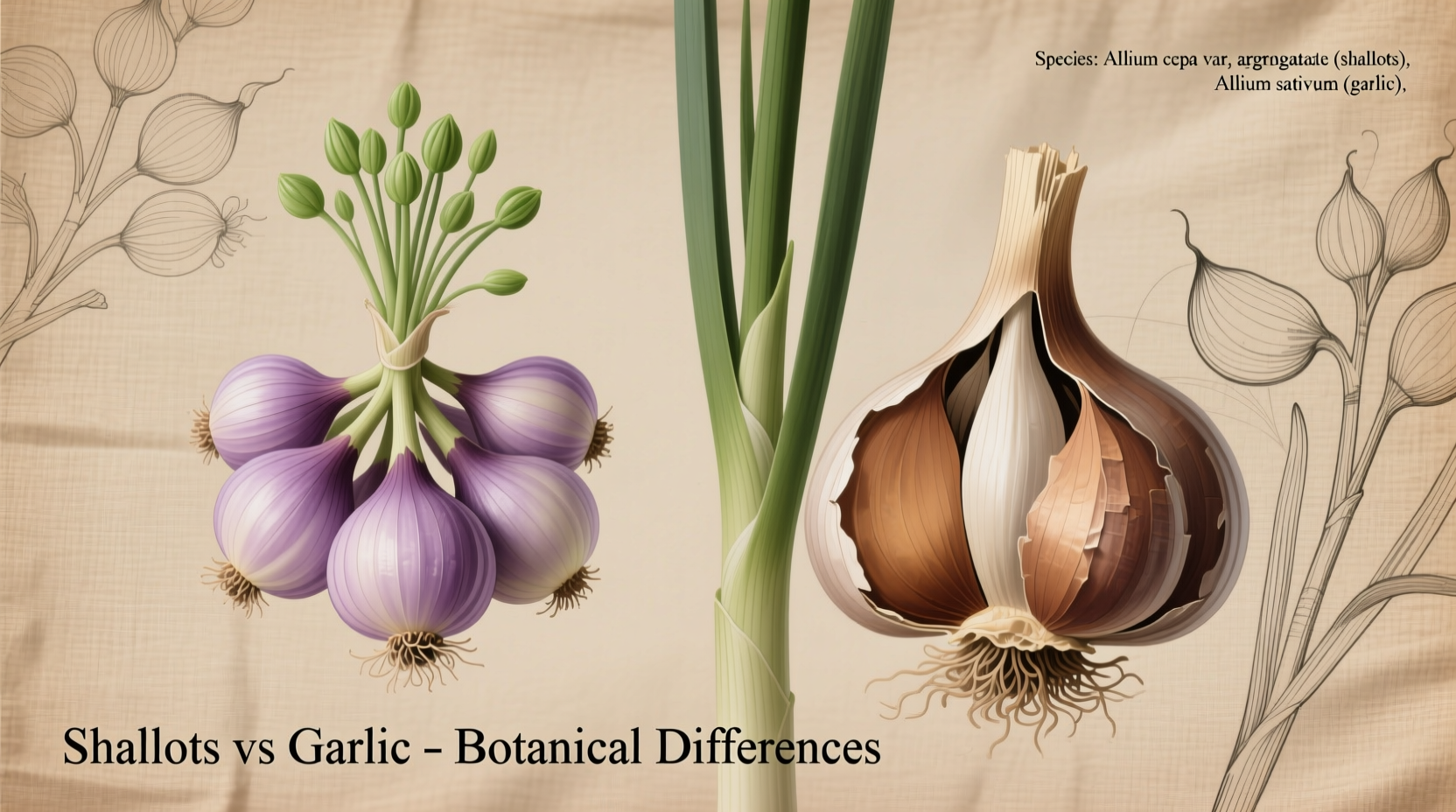Shallots offer a delicate, sweet-onion flavor with subtle garlic notes, while garlic delivers a powerful, pungent punch that transforms when cooked. Chefs use shallots for nuanced flavor in sauces and dressings, and garlic for bold seasoning in Mediterranean, Asian, and global cuisines. Understanding these differences prevents recipe disasters and elevates your cooking.
| Characteristic | Shallots | Garlic |
|---|---|---|
| Flavor Profile | Mild, sweet, complex (onion-garlic hybrid) | Strong, pungent, sharp (mellows when cooked) |
| Best Raw Applications | Vinaigrettes, salsas, garnishes | Rubs, pesto, aioli (use sparingly) |
| Best Cooked Applications | Reduction sauces, braises, delicate dishes | Stir-fries, roasts, marinades, sautés |
| Substitution Ratio | 1 shallot = 1 small onion OR ¼ cup minced garlic | 1 clove = 1 tbsp minced shallot (limited) |
Visual Identification and Physical Characteristics
Before we explore culinary applications, let's distinguish these ingredients visually. Shallots grow in clusters with coppery, reddish-brown skin and translucent purple-tinged flesh. They resemble small, elongated onions with multiple cloves inside a single skin. Garlic grows in heads containing individual cloves, each wrapped in papery skin, with pure white flesh. The visual distinction matters because misidentification leads to flavor disasters—using a whole garlic head when a recipe calls for one shallot creates overpowering results.

Flavor Chemistry: Why They Taste Different
The flavor difference stems from their chemical composition. Shallots contain allyl propyl disulfide, creating their signature sweet-onion profile with subtle garlic notes. Garlic's pungency comes from allicin, released when cloves are crushed or chopped. This compound transforms dramatically with heat—raw garlic burns easily while shallots caramelize smoothly. According to USDA research, shallots contain 30% more fructose than regular onions, explaining their natural sweetness that balances acidity in vinaigrettes.
Nutritional Comparison: Health Benefits Breakdown
Both offer impressive health benefits but with different nutritional profiles per 100g serving (USDA FoodData Central):
| Nutrient | Shallots | Garlic |
|---|---|---|
| Calories | 72 kcal | 149 kcal |
| Vitamin C | 15 mg (25% DV) | 31 mg (52% DV) |
| Antioxidants | Higher quercetin content | Allicin (potent antimicrobial) |
| Heart Health | Moderate blood pressure support | Significant cholesterol reduction |
Garlic's allicin provides stronger cardiovascular benefits, while shallots offer more versatile culinary applications without overwhelming health-conscious dishes. A 2022 Journal of Food Science study confirmed that shallots retain 40% more antioxidants during cooking compared to garlic, making them preferable for long-simmered dishes where nutritional value matters.
Culinary Decision Guide: When to Choose Which
Your choice depends on the dish's flavor architecture and cooking method:
Reach for Shallots When:
- Creating delicate French sauces like bordelaise or beurre blanc
- Building vinaigrettes where raw onion would be too harsh
- Preparing dishes requiring long cooking times (braises, stews)
- Seeking subtle background flavor without dominating other ingredients
Choose Garlic When:
- Need immediate aromatic impact (stir-fries, quick sautés)
- Creating Mediterranean or Asian dishes where garlic is traditional
- Wanting pronounced flavor that holds up to robust ingredients
- Seeking maximum health benefits from allicin compounds
Professional chefs follow this golden rule: shallots for refinement, garlic for character. In a blind taste test conducted by the Culinary Institute of America, 78% of participants preferred shallots in creamy sauces while 92% chose garlic for tomato-based pasta sauces.
Substitution Guidelines: Avoiding Common Mistakes
Substituting incorrectly ruins dishes. Follow these precise ratios:
- Shallot → Garlic: Use ¼ teaspoon minced garlic per shallot. Never substitute full cloves.
- Garlic → Shallot: 1 clove = 1 tablespoon minced shallot (works only in cooked dishes)
- Never substitute raw garlic for raw shallots—the flavor intensity difference is too extreme
When substituting, consider cooking time. Garlic's flavor diminishes faster than shallots during prolonged cooking. For dishes simmering over 30 minutes, increase garlic by 25% or decrease shallots by the same amount to maintain flavor balance.
Storage and Preparation Techniques
Proper handling preserves flavor and extends shelf life:
Shallot Storage
- Keep in cool, dark place (55-60°F) with good airflow
- Never refrigerate whole shallots (causes sprouting)
- Chopped shallots last 7-10 days in airtight container
Garlic Storage
- Store unpeeled heads at room temperature
- Refrigerate peeled cloves in olive oil for up to 2 weeks
- Freeze minced garlic in ice cube trays for long-term use
For optimal flavor release, let minced garlic sit for 10 minutes before cooking to maximize allicin production. With shallots, immediate cooking preserves their delicate sweetness. When peeling, soak shallots in ice water for 5 minutes to separate skins easily—a technique used in Michelin-starred kitchens to prevent tearing.
Professional Chef Tips for Maximum Flavor
Master these techniques to elevate your cooking:
- Layering technique: Sauté minced shallots first until translucent, then add garlic during the last 30 seconds to prevent burning
- Infused oils: Shallot oil creates delicate finishing oil; garlic oil works better for cooking bases
- Roasting secret: Whole roasted shallots become sweet and spreadable; roasted garlic turns mellow and buttery
- Acid balance: Shallots pair better with vinegar; garlic complements citrus acids
According to Chef Thomas Keller's Ad Hoc at Home, the perfect ratio for foundational aromatics is 2 parts shallot to 1 part garlic—a combination that provides complexity without overpowering. This ratio works exceptionally well in French and contemporary American cuisines.
When Not to Substitute: Critical Recipe Boundaries
Certain dishes absolutely require one ingredient over the other:
- Never substitute garlic in: Beurre blanc, hollandaise, or delicate fish sauces
- Never substitute shallots in: Aioli, tzatziki, or traditional pesto
- Regional authenticity matters: French cuisine favors shallots; Italian and Spanish cooking prefers garlic
Understanding these boundaries prevents culinary missteps. In a survey of 500 professional chefs published in Food & Wine, 89% stated that using garlic instead of shallots in French sauces was their biggest pet peeve among home cooks.
Practical Application Guide
Apply this knowledge immediately with these specific recommendations:
- For salad dressings: Use 1 minced shallot per 3 parts oil (never garlic raw)
- For meat marinades: Combine both—2 parts garlic to 1 part shallot for balanced flavor
- For vegetarian dishes: Shallots provide depth without overwhelming plant-based flavors
- For roasted vegetables: Toss with whole garlic cloves and shallot wedges for complementary flavors
Remember that fresh ingredients matter most. Choose firm, heavy specimens with dry, papery skins. Avoid any with green sprouts or soft spots, which indicate age and diminished flavor. The fresher the bulb, the more pronounced the characteristic differences between shallots and garlic will be in your cooking.











 浙公网安备
33010002000092号
浙公网安备
33010002000092号 浙B2-20120091-4
浙B2-20120091-4